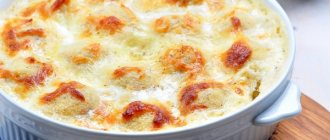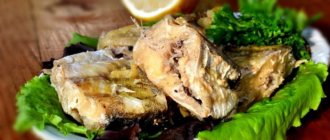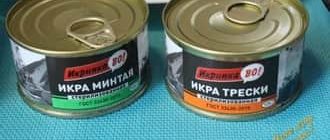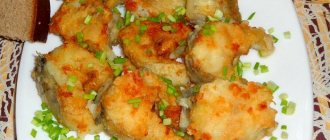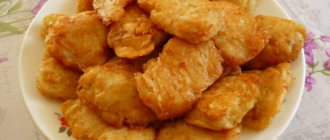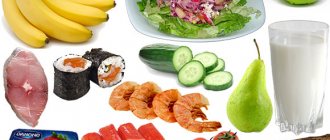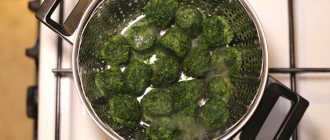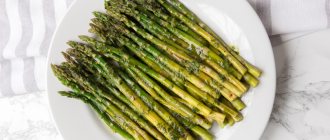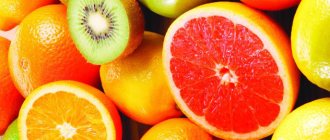Chemical composition and calorie content
You can buy hake in most large stores. Most often it is offered frozen. By freezing the fish retains its nutrients.
The composition contains Vitamins A, Vitamins B, C, D, PP, micro- and macroelements, such as: calcium, iron, cobalt, potassium, sulfur, phosphorus, nickel, copper, iodine, zinc, magnesium, fluorine.
Fish contains a lot of proteins and fatty acids.
If you take 100 grams of hake fillet, it will contain 86.002 kcal. At the same time, boiled meat in the same amount contains 84.203 kcal, baked meat – 92.316 kcal, fried – already 105 kcal.
Pollock is a fish available to almost every family, despite the crisis. This fish is rich in phosphorus, iodine, potassium and sulfur. It contains a fairly high percentage of vitamins A, PP and E. A large amount of B vitamins makes pollock useful for the functioning of the brain, nervous system, heart and blood vessels.
The calorie content of pollock is low - about 70 kcal per hundred grams. Pollock can be eaten even during diets. This fish nourishes the body with all the necessary elements and perfectly satisfies the feeling of hunger. Pollock is good for teeth, hair, skin, lungs and after serious illnesses. Pollock is necessary for people who are iodine deficient.
Pollock has a low cost, but is not inferior in usefulness to other types of fish. Pollock also contains a lot of useful substances, and this fish is useful during pregnancy. There are practically no contraindications for eating pollock. The only thing is that salted fish may be contraindicated for diseases of the kidneys and gastrointestinal tract.
Interesting fact: thanks to its unique composition, low energy value and a wide selection of cooking methods, pollock is one of the most favorite fish among those losing weight, as well as those who monitor their weight and their own health. Tender dietary meat, which contains practically no bones, is used to prepare casseroles, cutlets, soups, and broths; in addition, fish is stewed, dried, salted, smoked, baked, etc.
Which fish is more valuable?
Merluza has a higher nutritional value. 100 g of its meat contains 18.3 g of protein, 1.3 g of fat, 0.2 g of Omega-3 acids and only 85 kcal. What is valued among weight control people.
Merluza meat is tender and white. That is why hake is recognized as an ideal product for dietary and baby food. In addition, it contains virtually no small seeds. And the ridge is easily separated during heat treatment. This fish is especially prized in Spain and Portugal.
However, the benefits of pollock are also undeniable. It contains 16 g of proteins per 100 g of product, but the fat content is low, only 1 g, and there are no carbohydrates at all. Therefore, its calorie content is only 70, which is ideal for those watching their figure.
The most useful part of this fish is the liver. However, meat also contains fluorine, potassium, calcium, phosphorus, B vitamins (including folic acid), PP, A, C.
External differences
Unscrupulous sellers replace a valuable product with a cheaper one, so you need to know their external differences. Since both fish have an elongated, slender body shape, when choosing, you need to focus on the color of the scales and the type of fins.
In hake, the color smoothly transitions from dark gray on the back to silver-white on the belly. There are three fins: on the ridge near the head a short one in the form of a triangle, followed by an elongated one, and on the belly it starts from the middle of the body and reaches the tail.
Pollock has a lighter spotted color. It has three separate fins on its back, and two more on its belly. It is also distinguished by an elongated, protruding lower jaw and a short antennae under the lower lip.
Cod fish, what is it?
Cod and pollock belong to the cod of marine inhabitants of the oceans. They, as a seafood product, are in demand not only by residents of coastal areas, but throughout the country. They are attractive:
- Its dietary, tasty, tender meat is rich in proteins, vitamins, and minerals, especially phosphorus and calcium.
- Recommended for inclusion in the diet of children and pregnant women , as well as during lactation.
- They are sources of iodine , which is necessary but scarce in many areas.
- Both types are low-cost fish products and are popular among the population.
The appearance and color of the scales of hake and pollock are noticeably different from each other:
- The hake has approximately the same thing: the back is grayish-black , and the belly and sides are light gray.
- Pollock has many frequent black spots light gray surface
- Externally, the body of the hake is elongated evenly along its entire length.
- Pollock is wider at the head and gradually tapers towards the tail.
- A barely noticeable barbel on the chin of pollock, a distinctive feature from hake.
- The hake has a short dorsal fin, which is located closer to the head, and another longer one with a notch.
- Pollock has three fins clearly visible on its back.
Hake and pollock included not only diversify the diet, but also strengthen the thyroid gland , a regulator of human health.
Choosing the right one
Fish of the cod family are popular in many seas of the northern hemisphere; they are not fussy eaters, so they grow well and quickly reach store shelves, reaching a certain size. Among them there are such as the “national” pollock - the leader in catch and the most affordable fish of the family, but there are also varieties that are less common and cost more, respectively. In this regard, the question arose, which is better haddock or cod, because for many this is a real exotic, although it has become increasingly common lately.
First of all, I would like to talk about their distribution area, external similarities and differences. All types of cod have some similarities, but each has its own distinctive features. As for our subjects, it is very difficult to distinguish them when cut, but if you buy the whole carcass, this can be done. Instead of a light (almost white) stripe along the body, the cod has a dark gray (almost black) stripe, above the fin, which is located near the head, there is a distinctive black spot, and the tail is not straight, but curved. Cod has small scales with a greenish tint, while those of its competitor are silvery, larger and difficult to clean.
The fish we studied is found in the northern part of the Atlantic Ocean, while the “head” of the family swims closer to the surface, and therefore more often ends up in fishermen’s nets. This means that more of it is caught and, accordingly, it costs less than haddock, which is considered a valuable game fish. Although it is difficult to argue about which is tastier, haddock or cod, since it depends on many factors, including the cooking method and the skill of the cook, we will compare the composition and beneficial properties.
What can be prepared from hake: recipes
Hake fillet and minced meat are perfect for a wide variety of dishes and homemade semi-finished products.
Cutlets
For cutlets, you can buy ready-made minced meat or cook it yourself. It is imperative to take into account that purchased fish mass, as a rule, contains a lot of frozen water, which must be squeezed out after defrosting.
To prepare minced meat, take an uncut carcass or fillet, thoroughly wash, dry and remove all bones and skin. The meat along with the onion is twisted through a meat grinder or crushed in a blender. Beat an egg into the minced meat, add salt, pepper, and seasonings for fish dishes. Mix everything thoroughly. Roll small balls from the finished mass, press them down, roll them in flour and fry on both sides in vegetable oil until golden brown.
Those who are fasting can replace the egg with 2 tbsp. starch.
You can add variety to your menu by replacing the usual classic cutlets with a dish in the style of Arabic lula kebab. For this you will need: 550–600 g of hake, 1 whole onion (onion), ½ purple onion, 2 tbsp. oatmeal or oatmeal, 100 g stale white bread, 40 g milk, 1 tbsp. mayonnaise or sour cream (at least 20% fat), a bunch of any herbs (fresh dill, parsley), salt, ground pepper, spices (optional).
Process:
- Wash the hake and remove scales and bones. Separate the fillet from the backbone and bones.
- Soak slices of wheat bread in milk until soft. Squeeze.
- Peel the onion and chop into quarters.
- Grind the fillet, soaked bread and onion quarters in a meat grinder.
- Place the minced meat in a bowl. Beat in the egg. Sprinkle oatmeal or cereal. Chop the greens.
- Mix the contents of the bowl well until smooth.
- Add salt, season, pepper and stir again.
- Transfer the mixture into a clean plastic bag and beat for 1-2 minutes.
- Roll the minced meat into small elongated sausages. Place each “sausage” on a long skewer and wrap tightly in foil.
- Place the preparations on a baking sheet and let it brew for a while.
- Place in an oven preheated to 180°, bake for about a quarter of an hour, unwrap and bake for another 10 minutes.
- Unwrap, place on plates and garnish with purple onion slices and sprigs of fresh herbs.
Lula kebab will acquire a special taste and aroma if it is cooked on the grill or fire.
Soup
First courses are an integral part of the diet of all people leading a healthy lifestyle. Soups with hake are suitable for all lovers of proper nutrition and will diversify the menu of any family. Everyone will find a recipe to suit their taste.
Simple recipe:
You will need: 400 g hake, 1 large onion, 1 medium carrot, 3-4 potatoes, 100 g millet, salt, pepper, bay leaf.
How to cook:
- Peel the onion, carrot and potato. Coarsely chop the onion.
- Grate the carrots or cut them into circles, potatoes into cubes.
- Pour the onions and carrots into the bottom of the pan, add water, bring to a boil and cook for 20 minutes.
- Wash the hake under the tap, remove dirt and scales, and cut into pieces.
- Rinse the millet thoroughly with clean water.
- Place potatoes, hake and millet in the broth, bring to a boil and skim off the foam.
- Salt, add black peas and bay leaves.
- Cook for 20–25 minutes until the millet and potatoes begin to fall apart.
Connoisseurs of unexpected flavor combinations will love Spanish fish soup with orange juice.
You will need: 1 kg of hake meat, 1 tomato, 4–5 small potatoes, 2 medium oranges, 2 small lemons, 2 tbsp. olive oil, 5 cloves garlic, 1 large onion, 1 tsp. paprika, salt, pepper, 30 g parsley, 1.2 liters of water.
Process:
- Wash, remove scales and dirt and gut the fish. Separate heads, ridges, bones and tails. Remove the gills from the severed heads.
- Place all parts of the hake, except the fillet, into a pan filled with water.
- Remove the skins from the oranges. Place the skin in a saucepan and bring the water to a boil. Remove the foam. Cook for half an hour covered.
- Place the fillet parts in a bowl, add salt and place in the refrigerator.
- Pour oil into a thick-walled pan (preferably cast iron) and heat it up.
- Crush the garlic directly in its husk and fry in a saucepan until golden brown.
- Remove the garlic. Reduce heat.
- Throw the peeled and chopped onion into the pan and fry until soft. Add chopped tomato.
- Pass the broth through sterile gauze or a sieve, then pour into a pan with vegetables.
- As soon as the water boils, add the potatoes. Cook for 5 minutes.
- Place the fillet in the soup and continue cooking for about 20 minutes after foam appears.
- Using a juicer, squeeze out the juice from all citrus fruits and pour it into the broth.
- Salt, add paprika, pepper.
Before serving, garnish with fresh herbs. Serve the soup hot.
Salad
Hake is able to update and embellish long-familiar food. One of these traditional dishes is Olivier salad. One has only to replace meat with fish, and the salad familiar from childhood will sparkle with new colors.
You will need: 200 g potatoes, 100 g carrots, 100 g green peas, 2 boiled eggs, 100 g hake, 50 g green onions, 5-6 tbsp. mayonnaise, salt (to taste).
Process:
- Wash the potatoes thoroughly and boil in their skins until tender. Remove the peel and chop into cubes of about 1 cm each.
- Also wash the carrots thoroughly and boil them in their skins (you can cook them in the same pan with the potatoes).
- Remove the peel from the finished carrots and cut the carrots into small cubes.
- Boil green peas (fresh or frozen), use canned food or homemade pickled product.
- Place the peas in a sieve or colander and allow excess liquid to drain.
- Boil the eggs until the yolks are firm (approximately 10 minutes), remove the shells and finely chop with a knife.
- Remove the washed fillet from small bones and cook for 15 minutes.
- Place the fish in a colander and let the water drain. Finely chop the fish meat.
- Separate the onion from the peel and chop very finely.
- Combine vegetables, eggs and fish in one bowl. Stir well.
- Salt, season with mayonnaise, add a pinch of ground pepper. Stir again.
- Leave in the refrigerator for about 3 hours. Some housewives advise dressing the salad with mayonnaise immediately before serving.
We recommend reading:
what can be cooked from pangasius Read
Pike
Pike is a freshwater fish, and the only one in its family. The highest culinary qualities are found in medium-sized individuals, from two to two and a half kg. This is also a dietary product, low-fat, with a high protein content, suitable for people watching their weight. But it should not be consumed in large quantities.
Quite powerful antiseptics have been found in meat, strengthening our immune system and resisting viruses. By the way, it is especially recommended to use it during upcoming flu epidemics, as a preventive measure.
Fish contains a lot of easily digestible phosphorus and calcium. It contains a lot of cobalt, as well as Ca, Mg, Na, S, Fe, Zn, I, Mn, Mg, F, etc. Fish is recommended for those who have skin problems caused by a lack of vitamin B and often “grabbing” viral infections. It reduces the likelihood of arrhythmia. The protein contained in pike is absorbed many times better than the animal, so the fish is useful for problems with the gastrointestinal tract. She is especially loved by French women, who are accustomed to taking care of their appearance and, in particular, their figure.
Pike is a fleshy fish with easily removable skin. It is convenient to stuff it. It is delicious baked, stewed, dried, or boiled. Great for making meatballs, cutlets, rolls.
Contraindications. No substances that could be considered potentially dangerous were found in pike. Moreover, the meat is hypoallergenic. The main thing is to know where this fish was caught. There are no contraindications, unless individual intolerance is taken into account.
What products does it combine with?
The right combination of ingredients will not only highlight the taste of the fish, but will also help avoid problems with digestion. In addition, following the rules of a healthy diet leads to weight loss and clearer skin.
Compatibility table with other products
| Fine | Ghee, whey, greens, cabbage, carrots, beets, pickles, green vegetables |
| Acceptable | Rice, buckwheat, lemon, quinoa, tomatoes, butter, vegetable oil, pumpkin, eggplant, zucchini |
| Badly | Meat, poultry, eggs, mushrooms, cream, sour cream, lard, nuts, seeds, potatoes, dairy products, cheeses, feta cheese, wheat, rye, oats, bread, peas, chickpeas, mung beans, beans, beans, lentils, |
The benefits of pollock
Pollock, from the cod family, is caught mainly in the cold waters of the Pacific Ocean and, in terms of production volumes, ranks first in comparison with other cod fish, including hake. In the area of the Kuril ridge, Sakhalin Island, and the Far East, pollock is considered not only tasty, but light and healthy food . Due to its availability, every family loves this fish and knows how to cook it properly.
The nutritional value
Pollock fish is rich not only in nutritional composition, but also in a large number of microelements and vitamins . It contains quite a lot of proteins, fats and almost no carbohydrates.
- There is little fat, only 0.9 g per 100 g of product, which makes fish useful in diets.
- There is quite a lot of protein of animal origin, about 15.9 g per 100 g , which is 500 g, which is the daily requirement for an adult.
- Among the vitamins there are “A”, “E”, group “B” , especially “B12” .
- Vitamin PP , nicotinic acid, involved in the formation of enzymes in living cells.
- There are a large number of macroelements in pollock, providing up to 30% phosphorus, potassium and magnesium in 100 g of pulp. And also 100% iodine, 150% cobalt and 110% chromium.
- Omega-3 unsaturated fatty acids provide about 20% of the norm.
- Pollock is famous for its low calorie content of 70 kcal per 100 g .
The benefits of pollock for the body
Pollock has great nutritional value:
- It is recommended to be used in all therapeutic and health diets; it satisfies the body with its rich chemical composition and does not cause a feeling of hunger .
- The composition of micro and macroelements is beneficial for tooth enamel, ensures hair growth, and improves skin condition.
- Pollock is recommended to be included in the diet for many diseases , such as endocrine system failure, diabetes, diseases of the cardiovascular system , and housing and communal services diseases.
- For people who lack iodine , it is recommended to eat it regularly.
- For those who are obese , pollock is useful as a low-calorie product.
General information
Hake is a fish of the hake family. It can live at depths of up to 900 m. It is caught by fishing vessels of many countries in the Pacific and Atlantic oceans. The special taste and aroma of the caught hake does not last long. To preserve these qualities, they try to freeze the fish as quickly as possible.
Hake
Pollock is a member of the cod family. Lives in the Pacific Ocean. Prefers to live in cold waters. In terms of production volume, pollock is in first place among all cod-like fish.
Pollock
Hake is a tasty and healthy fish
The cost of hake is slightly higher than that of pollock. This fish has lower calorie content and is also suitable for dietary nutrition. Hake is rich in iron, phosphorus, calcium, iodine, chromium, sodium and potassium. It contains a fairly high percentage of vitamins B, PP, C, A and E. Hake is richer in healthy fatty acids, which cannot be produced independently by the body.
Hake effectively normalizes digestion and removes carcinogenic elements from the body. A large number of antioxidants contained in fish have a positive effect on the heart and blood vessels. Hake is good for the thyroid gland, skin and hair. Hake contains Omega 3, which is why it should be eaten regularly.
Eating hake will help you avoid depression and nervous disorders. Hake is good for the heart and blood vessels. It makes our body stronger and helps strengthen the immune system. You can add fish to almost any dish - from soups to cutlets. It is very healthy to eat hake stewed with vegetables.
When choosing between pollock and hake, you should be guided by your taste preferences. For some people, hake seems like a rather bland dish.
However, a small amount of fat is good for people, especially those prone to excess weight. Hake contains more useful elements and fatty acids, but its cost is higher.
It is not necessary to eat hake or pollock every day, unless you follow a Mediterranean diet. It is advisable to eat fish dishes at least a couple of days a week. This will strengthen the body and prevent many diseases.
When choosing between these two fish, you must focus primarily on your own taste priority. Some consumers complain that hake is too bland. But for those who tend to gain excess body weight, it is more beneficial. To save money, you can avoid eating fish every day. This regime is extremely important only for those on the Mediterranean diet.
Pollock will be tastier, hake is too dry. It can only be stewed. And pollock is good fried and marinated. They have the same bones.
In terms of nutritional value, hake is valued higher here. It contains more substances important for our body and is easily absorbed. Hake is recognized as an ideal product for dietary and baby food.
If you go by taste, many also prefer hake, noting that its meat is more tender. Often this fish is simply fried. But since a lot of vitamins are lost during such processing, it is more useful to use baking or steaming.
Recipes with hake are very diverse, and an important role here is played by the fact that there are few bones in such fish.
Pollock can be called a fish for everyone. Some people find it quite dry. But pollock liver is considered a delicacy, and also very healthy, rich in vitamin A. An equally popular product is pollock caviar.
It is not difficult to guess the difference between hake and pollock in terms of their price. You will have to pay more for hake. Pollock is one of the most accessible types of fish for the general population.
( 4 ratings, average 2.25 out of 5 )
Hake
Hake is considered a commercial fish. To prevent it from losing its taste and smell, it is processed immediately after it is caught. This is how the complete preservation of all the beneficial properties of this fish is ensured.
Hake is good for blood vessels and the heart. Another advantage is that the pulp contains a large amount of antioxidants.
This fish helps remove carcinogens from the body, and is also useful for those people who often have digestive problems.
Hake contains a large amount of omega-3 acids. They are necessary for the normal functioning of the thyroid gland. This product also has a beneficial effect on hair growth and scalp.
Hake is useful to eat to strengthen the immune system, and this fish also helps with nervous disorders.
It has been observed that this particular type of fish helps lower blood sugar levels. Therefore, hake is useful for people who suffer from diabetes.
pollock is healthier than hake
pollock is healthier than hake
What are the differences?
Pollock and navaga - these close relatives of cod are constantly found in store windows and fish markets. The choice between them is fundamentally important. Speaking about navaga, it is important to take into account that this name includes both Far Eastern and northern fish. The size of both types is very small. It reaches a maximum of 0.5 m, and even then relatively rarely.
Most specimens of navaga sold in Russian retail chains are much smaller than the limit values. The taste of the Pacific and polar varieties is very similar. Experts believe that he is delicate and gentle.
Navaga meat contains a lot of selenium, which is important for the nervous system. And it also contains a significant amount of iodine.
Navaga allows you to partially cover the need for:
- retinol;
- B vitamins;
- vitamin D
In terms of these components, however, pollock is not inferior to its “rival”. Both types contain a significant amount of Omega-3 polyunsaturated acids. The energy value of navaga is less than that of pollock. Therefore, it is much better suited for dietary nutrition. Otherwise their quality is the same.
You can see how to cook pollock in the oven in the following video.
Product comparison: which is better?
It’s worth saying right away that it’s unlikely that even an experienced merchandiser will be able to distinguish pollock from frozen cod. Pollock in its pure form is easy to recognize by the brightly colored line on its side. But the spotting, the number of fins, and the “whiskers” are completely the same. Pollock can only grow up to 0.8 m. The maximum size of adult cod reaches two meters, and it is slightly rounder.
Pollock is highly valued by culinary experts in Asian countries. Fishing for this breed has grown in recent decades to such an extent that its population has begun to decline. Its meat is equally tasty, regardless of the season. But cod is most enjoyable in the fall. Then the schools of fish go to spawn, having accumulated many useful substances. The caviar of both fish is equally useful.
Speaking about the benefits of pollock and cod, we must take into account that both types contain noticeable amounts of:
Contraindications and recommendations
Sea fish pollock and hake which are similar in composition , are very healthy and are recommended for almost anyone to eat in a variety of dishes, as an independent product or as a component in other recipes.
In some cases, they may be contraindicated for use according to the following recommendations:
- Individual intolerance to fish products in general or pollock and hake separately. They are not recommended for those with seafood allergies.
- Seafood products from pollock and hake may contain excessive amounts of salt , which is not recommended for people with high blood pressure or irritation of the mucous membranes of the stomach.
- All marine fish are often infected with parasites. If their presence is detected or suspected, it is better to stop using them.
- Sea fish cannot be eaten raw, only after heat treatment.
- People suffering from constipation are not recommended to eat these types of fish in large quantities due to the presence of iron in them, which acts as a binder for digested food.
- For those who experience increased acidity in the body , it is recommended to eat fish food in small quantities so as not to cause irritation in the stomach.
- Pollock and hake fish are not very bony , but they are chosen with the greatest care for children.
Improper storage of fish can cause poisoning with serious consequences .
Conclusion
The choice between pollock and hake, which of them is more useful, is definitely difficult and useless. Both types are almost equally healthy and contain great nutritional value , almost equal in calorie content. Contraindications and recommendations apply to both hake and pollock.
They differ in size, weight and appearance, and most importantly, in cost, by about one and a half times. The price difference is explained by the fact that hake is more difficult to preserve, while pollock is caught in larger quantities, making it more affordable.
The choice depends on the personal preferences of the consumer and his finances.
Hake, pollock and blue whiting. 5 delicious dishes from inexpensive types of fish
The other day, statisticians said that in Europe people began to eat more fish and seafood. Thus, more than 42% of EU residents arrange a weekly fish day. Moreover, the leadership of a number of countries, for example, Belgium, is concerned that there may even be a shortage of these products in the future.
The same, alas, cannot be said about Russia. Thus, in 2021, fish consumption in our country dropped significantly and showed a record low level - less than 15 kilograms of fish per person per year. This is five kilograms less than the minimum established by the Ministry of Health! And the numbers haven't improved since then.
One of the reasons for this decline is the high cost of fish - its cost is constantly growing and, accordingly, is losing out to inexpensive chicken meat. However, on the market you can find affordable varieties of fish, from which it is easy to prepare truly tasty and healthy dishes. SPB.AIF.RU has collected several such recipes.
( 1 rating, average 5 out of 5 )
Hake with turmeric in the oven
Hake is considered the healthiest of the cod family. Plus, it is very convenient to cook and eat - hake has few bones. On the market, the price per kilogram of this fish starts from 200 rubles, fillet will cost around 300 rubles.
You will need:
- 2 kg hake carcass
- 2 onions
- 1 tbsp. flour
- 1 tbsp. turmeric
- Salt.
How to cook:
Wash the fish thoroughly, cut off the fins, gut and cut into portions. Place the hake in a deep bowl and add salt. Sprinkle with turmeric and mix. Line a baking tray with baking paper. Now you need to place the fish on a baking sheet, sprinkle with chopped onion in half rings. Leave to bake for 40 minutes at 180 degrees. The dish is ready.
How to select and store
To choose a high-quality hake, you should be careful.
If the fish is sold not frozen, you should find out whether the fillet plates are separated from the bones. To do this, just pick up the flesh near the ridge - if it easily comes off the bone, it means the fish is not the freshest.
The flesh of fresh fish is more elastic when pressed, so after a while the dent on its surface becomes invisible; in fish with a long shelf life, looseness is observed; when pressed, the meat remains pressed in and can be sticky to the touch.
The freshness of hake can also be determined by its smell - it should have a pleasant fishy aroma, and not give off unknown chemical compounds or not smell at all. In the latter case, this may also indicate that dangerous chemicals were used to preserve the fish, neutralizing the natural aroma of the fish.
If the frozen hake is too light in weight, this may mean that it has been frozen for a long time and during this time has had time to “dry out”. There are almost no beneficial properties left in such fish.
The buyer should also be wary of an excessive amount of ice glaze around the hake carcass; this is evidence of re-freezing or an attempt to disguise its real shelf life.
Since hake in its raw form quickly loses its valuable qualities, it is preserved by “shock” freezing, that is, by quickly reducing the temperature to -18-240. At home, it should be stored in the freezer and under no circumstances should it be re-frozen.
Culinary properties of hake
This fish has excellent taste and nutritional properties. The cooking method can regulate its calorie content. Hake is good fried, baked, or stewed. The flesh of this fish has almost no bones, making it excellent for minced cutlets and filling for pies.
Merluza is tasty, has tender white meat, not dry at all, and does not have any specific smell or taste. The fish must be frozen, after which it does not lose its properties.
Use in cooking
Without exaggeration, hake can be called a universal fish. It can be subjected to any heat treatment:
- Boil the whole piece in salted water or cook the fish soup;
- stew with vegetables;
- bake in the oven;
- fry in vegetable oil and on a spit;
- grind into minced meat and make quenelles or cutlets from it, as well as filling for fish pies.
Hake quenelles (meatballs) are popular in European countries; cutlets fried in breadcrumbs are most popular in Russia. And fish pies are in particular demand among people who observe multi-day fasts and who simply love the fish and onion spirit inside the fragrant dough. Hake makes excellent appetizers, first and second courses. This fish is pleasant to cook due to the absence of large scales and small bones.
In industrial cooking, hake waste (heads and entrails) is processed - ground into fishmeal. Loin trimmings are used to make surimi and imitation crab meat.
Chum salmon with herbs in the oven
For lovers of fish from the salmon family, chum salmon is one of the most budget options. If the cost of trout or salmon in stores today starts at 600 rubles per kilogram, then chum salmon will cost you half as much.
You will need:
- 250 g chum salmon (steak or fillet)
- 2 tbsp. lemon juice
- 2 tbsp. olive oil
- Herbs and spices – basil, rosemary, coriander
- Salt pepper.
How to cook:
We start with the marinade: mix lemon juice, olive oil, salt, pepper, spices and some fresh herbs. Coat a piece of chum salmon with the resulting marinade. Leave at room temperature for 10 minutes to marinate the chum salmon. Then put it in the oven, preheated to 180 degrees, and bake for 10-15 minutes (the exact time depends on the size of the piece of fish). We take it out and serve it to the table.
Guide to Saltwater Fish
And I like to fry pollock, salmon and trout are also delicious. Mackerel in foil is very tasty. I knew, I hoped that Kitty would not pass by the fish.
The variety of species of sea fish is amazing: from one centimeter to two tens of meters, from several grams to hundreds of kilograms, loving heat or cold, bottom or surface - fish are very different. It is believed that the underwater world has been studied less well by humans than outer space.
But I don’t take this one, because the refrigerated one won’t reach us. Fresh only river and canal, I try to buy this one only alive. And we prefer to fry blue whiting. Each person gets a small whole fish, or two, whoever has time.
Delicious fish and few bones. And my mother likes to fry sprat, it always looks appetizing - there are even rows of fish in the frying pan. Sea bass is quite an expensive fish.
Distribution area and external differences
Previously, we only cooked fish soup from it. Quote: nata from Thursday, June 14, Good topic! And I love fish very much, Cancer herself, where would we be without fish? I’ll share my “works”.
About freezing. Hake and pollock are good for cutlets, cod and tuna have appeared, all of our fish are in approximately the same price category, UAH. If this does not happen, keep it no more than 48 hours, or better yet, in the refrigerator. Nutritionists insist that regularly including sea fish in your diet will help maintain your health. Let's figure out which of the inhabitants of the deep sea should be given preference.
